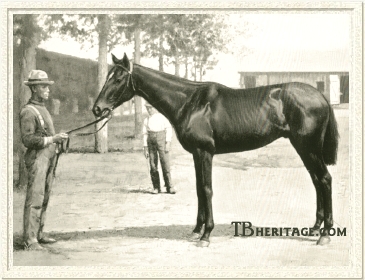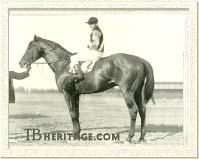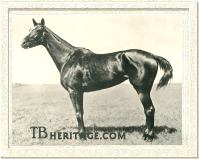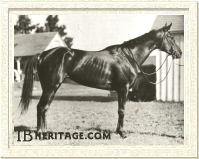|
|
Plaudit

|
|
 |
|
|
The male line of Alarm via his son Himyar dominated as one of the three triumvirate sirelines in American racing in the early Twentieth Century -- the other two lines were those of Ben Brush and Fair Play. Himyar's line flared brightly through Domino and Domino's precious few sons and daughters to become one of the most potent sources of brilliant speed in world breeding. But another son of Himyar also established a male line of influence, one that, along with Domino's, survived into the Twenty-First Century by a tiny strip, culminating in the most recent Kentucky Derby winner (2005), Giacomo. This is the sireline of Himyar's "other" son, Plaudit.
Plaudit's dam, the high-strung imported mare *Cinderella earned similar distinction as her mate, Himyar, since she was also the progenitor of two sons who were important links in two of the trio of American sirelines. Besides Plaudit, she also produced Spendthrift's son Hastings, sire of the mighty Fair Play, and so grandsire of Man o'War. These two male offspring have earned her recognition as an American mare as significant as Pocahontas in England's Nineteenth Century, dam of the three important sons Stockwell, King Tom, and Rataplan by three different sires, creating links in three distinctly unrelated male lines.
|

Cinderella
| |
In 1886, Dr. J.D. Neet of Versailles, Woodford County, Kentucky acquired the yearling filly *Cinderella along with another filly, *Tarantella, from the sale consignment of Alfred Withers, who had sent them from England as part of a draft of mares and fillies to be sold in the U.S. by Egmont Lawrence. Both proved exceptional broodmares (*Tarantella produced Joe Madden, Handsel, Amalfi, Pentecost, and several other very fast horses) but *Cinderella left the greater legacy to the breed.
|
From thirteen foals, Cinderella got four stakes winners - Handsome, Hastings, Plaudit, and Glenheim; two major sires in Hastings and Plaudit; and her last foal, the filly Slippers (1904), proved an important broodmare in the H.P. Whitney stud. Slippers was the dam of Preakness winner Buskin and the winner Polly Flinders (dam of Macaw, Prudish, and Prudery).
*Cinderella's breeding was recorded as being by "Blue Ruin, or Tomahawk" in the General Stud Book, although the order was switched in the American Stud Book.
Plaudit on the Turf
In 1897, Plaudit appeared on the racing scene as the promising younger brother of the high class Hastings, winner of the previous year's Belmont Stakes. The bay Plaudit (1895) entered training under the tutelage of Ed Brown, a noted Afro-American trainer also known as "Brown Dick," who had gained recent fame following the success of the great Ben Brush (1893), who he had trained as a two-year-old. Plaudit also made an early name for himself when winning the Emerald Stakes, run in July at Cincinnatti. In New York, he ran fourth in the rich Futurity Stakes (won by L'Alouette), where he caught the eye of horseman John Madden, who already owned and trained the season's top juvenile, Hamburg. Madden bought Plaudit for $6,500, and for his new owner, the Himyar colt pulled an astonishing upset at 40 to 1 odds when beating the older champion Ben Brush in an overnight purse in September. Going a mile and a sixteenth, the two-year-old Plaudit went wire to wire and held off the four-year-old by a nose.
The next month, Plaudit finished his juvenile season with victories in the Nursery Stakes and Champagne Stakes, but bowed to Hamburg as the division champion by reputation. Plaudit ended the season with four wins in a dozen starts, and besides his three stakes wins, also placed second in the Dash Stakes.
At three, Plaudit ran eight times and was a model of consistency, winning half and running second in the other half. In his season debut, he caught the "runaway" front runner Lieber Karl at the Churchill Downs wire to score by a neck in the Kentucky Derby in a small field of four. He followed up with successive wins in the Clark Stakes (also at Churchill Downs), Oakley Derby (Cincinnatti), and walked over in the Buckeye Stakes. He then ran second in the St. Louis Derby and Latonia Derby.
On another front, Madden was just cranking up Hamburg, who debuted with a third place finish in the Belmont Stakes (to Bowling Brook and Previous), and sprinted to wins in the Spring Serial Stakes and Swift Stakes. At this stage, Madden, knowing the measure of both colts, accepted an offer of $25,000 from W.C. Whitney for Plaudit, who was promptly trounced by Hamburg in their first mutual start, the Lawrence Realization. The Himyar colt ran in Whitney's colors just once more, second in an overnight, before breaking down. Madden relieved Whitney of the cripple for just $12,000, making one wonder why the millionaire continued to do business with Madden over the next few years after being taken advantage of so badly.
Plaudit, who had compiled a record of eight wins in 20 starts over two seasons, earned $32,065 racing, and a spot as one of the first stallions to stand at Madden's newly established stud farm, standing his first season in 1899. The property to the east of Lexington was named "Hamburg Place," and had been purchased that same year with the $30,000 the trainer received from selling Hamburg to Marcus Daly.
Plaudit in the Stud
Plaudit proved a useful stallion but was never Madden's premier sire, and he was farmed out to other locations on occasion. In his early years, he played second fiddle to the short-lived *Mirthful; later to *Ogden, *Sandringham, Yankee, *Plaundes, and Uncle, then was completely overshadowed when the great *Star Shoot was moved from Runnymede Farm in Paris to Hamburg Place in 1911.
A photo of Plaudit in training illustrates a lean, mean, racing machine. A bay with a star as his only white, he was sparely made, and not a picture horse at that. His thin, ewe neck was set on at an unattractive angle, coming fairly straight out of his chest. His shoulders were markedly upright, as were his longish pasterns. He was a short-barreled, short backed horse with high withers and a sloping muscular hindquarter. His front legs were tied in below the knee, and his hindlegs appear a little weak and sickle-hocked. While not a picture horse, obviously the model could run fast, although not particularly far. In fact, he was made along very similar lines to his older brother Hastings, also more of a speed horse who had almost identical markings on his brown coat. The latter was a horse endowed with better muscling, although also seriously upright, light below the knee, and sickle hocked to a fault.
At Hamburg Place, Madden bred a dozen stakes winners sired by Plaudit, and the best of these was KING JAMES (b.c. 1905 out of *Unsightly by Pursebearer). King James was unlucky to have been born in a bumper crop that included the great Colin, his stablemate Celt, and their nemesis, Fair Play. A late bloomer at two, he still made ten starts, with his biggest score in the Tremont Stakes. At three, King James ran 16 times, winning the Annual Champion Stakes, but also second in the Brooklyn Derby (to Fair Play), Lawrence Realization (to Fair Play), Travers Stakes (to Dorante), Century Handicap and Crotona Stakes; and third in the Withers (won by Colin, with Fair Play second), Belmont Stakes (to the same pair), Empire City Handicap, Advance Stakes and Coney Island Jockey Club Stakes.
|

King James
| |
When the big colt was four, Madden sold King James to Samuel C. Hildreth, who had a championship season with him. He started the season in California with wins in the Burns, California, and Speed Handicaps, then came back east to score in the Metropolitan and Brooklyn Handicaps among his most important wins. He ran on three more seasons before retiring to stud in 1912 with career earnings of $104,155. A handsome, "bull of a horse" who required a lot of work, King James was remarkable for having a remarkably bad stride which prevented him from becoming top class.
|
King James was sold and went to the Blue Ridge Farm stud of Henry T. Oxnard, getting ten stakes winners from 158 foals. King James' leading runner came from his first crop, the Withers and Travers Stakes winner Spur (1913), who, retired to James Butler's stud in New York State, proved a useful although short-lived sire, getting four stakes winners from just 68 foals including the good Sting (1921), who won the Metropolitan, Suburban, and Empire City Handicaps. Sting, who retired back to Butler's farm, sired only two stakes winners from 122 foals, but one of these was the outstanding handicapper Questionnaire (1927), bred by Butler, but later sold to Greentree Stud in Kentucky, where he became a top class sire.
Questionnaire's best runners were the good colt Requested, My Request, and Miss Request, as well as the classy juvenile Free For All, who continued the line when he sired Santa Anita Derby winner Rough'n Tumble. Originally put to stud in Maryland, Rough'n Tumble was sent to Florida where he became one of the foundation sires of that state's breeding industry. He sired the 1968 Horse of the Year Dr. Fager, and several other useful sire sons including Minnesota Mac, who, when bred to Dr. Fager's half-sister Ta Wee, produced the sprint demon Great Above. Great Above sired a string of good runners, including the mare Big Dreams, dam of two-time champion sprinter Housebuster; but late in life, he got an equally brilliant colt in the grey Holy Bull, champion at three, and later sire of champion Macho Uno and 2005 Kentucky Derby winner Giacomo.
King James also sired the top class handicap mare My Dear, Saratoga Cup winner My Own, and Latonia Championship winner King Nadi. A King James daughter, Silencia, produced the ill-fated handicapper Dark Secret. Another, Belmona, was the dam of the Canadian champion filly Mona Bell, and her full sister Iribelle, a foundation mare for E.P. Taylor's Canadian breeding empire.
Besides King James, Plaudit also sired the good horse PLATE GLASS (c. 1906 out of Eliza Belle by Iroquois), probably the best handicapper in training when a five-year-old in 1911.
Aside from these two, males who improved with age, Plaudit's best stakes winners tended to show precocious speed. These included champion two-year-old filly SOUTHERN MAID (f. 1911 out of Sally K. by *Mirthful), Hopeful Stakes winner BRINGHURST (1911 g. out of Sweet Marjoram by *Dinna Forget), Spinaway Stakes winners RAGLAN (f. 1901 out of *Royal Gun by Royal Hampton) and CASUARINA (f. 1911 out of *Nun's Cloth by Melton), Flash and Grand Union Hotel Stakes winner EDWARD (c. 1906 out of Passan by Hamburg), Grand Union Hotel Stakes winner SIGLIGHT (c. 1902 out of La Creole by Spendthrift), also BECKON, LITTLE SISTER, and VIRGINIA YELL. His other good ones included California Oaks winner Eudora, also PLAUDMORE, HARRIGAN, ONAGER, and PLANUTESS.
King James was far and away Plaudit's most important offspring in the stud. Plaudmore (1906) went to stud in Canada and there sired two winners of the King's Plate, St. Paul (1917) and Maternal Pride (1921). Another son, King Plaudit (1916) was a stallion out west and became influential among stock horses, getting the Quarter Horse sire Plaudit, and the mares Plaudette (dam of the Appaloosa Bright Eyes Brother) and Queen Plaudit (dam of Gold Plaudit).
When the big colt was four, Madden sold King James to Samuel C. Hildreth, who had a championship season with him. He started the season in California with wins in the Burns, California, and Speed Handicaps, then came back east to score in the Metropolitan and Brooklyn Handicaps among his most important wins. He ran on three more seasons before retiring to stud in 1912 with career earnings of $104,155. A handsome, "bull of a horse" who required a lot of work, King James was remarkable for having a remarkably bad stride which prevented him from becoming top class. |
|  | |  | | Champion grandaughter Rose of Sharon | | ...and champion great-grandaughter Marica |
Plaudit's few good daughters included ROSA MUNDI (dam of the 1929 champion three-year-old filly Rose of Sharon, by *Light Brigade), CANBERRA (second dam of the 1937 champion handicap mare Marica, by *Epinard), and CASUARINA (third dam of the sprinter and sire Olympia).
Plaudit died in 1919 at the age of 24 and was buried in the Hamburg Place cemetery, a site now in jeopardy of succumbing to development at an interstate interchange on Lexington's Winchester Road. In 2005, Giacomo, a tenth generation male line descendant, won the highest reward for any Kentucky-bred when winning the Kentucky Derby, something his well-named ancestor Plaudit had also achieved with glory and honor in 1898.
--Anne Peters
|
|
|
|

